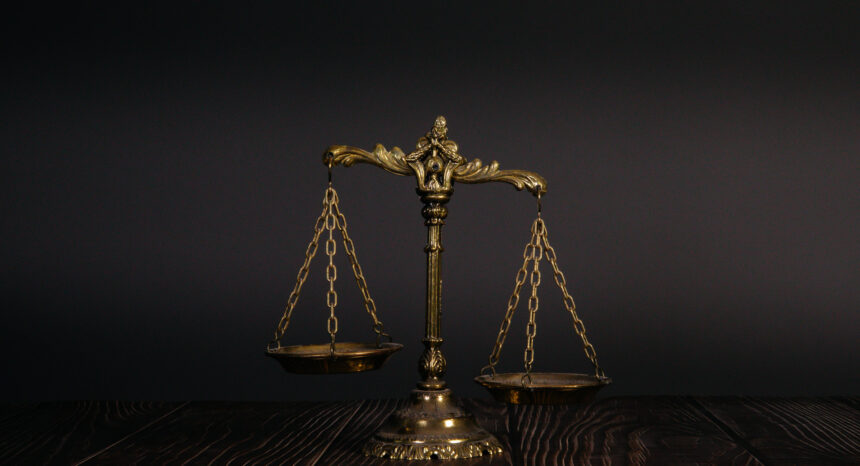In 2022, 30 public radio stations across 25 states asked listeners for their biggest questions in advance of that year’s election. What they learned: People really want to know how to judge the judges on their ballot.
The effort was part of the Midterm Election Project from America Amplified, a nationwide community journalism engagement initiative for public media, funded by the Corporation for Public Broadcasting.
Voters are often confronted at the polling booth with a list of judicial candidates. For civil court judge. Appellate court judge. Surrogate’s court judge. These positions are important because local and state judges, by the nature of the job, hold massive sway over people’s lives every day. Yet many voters have no idea who the candidates vying for these positions are or what kinds of work the various judges do.
“When it comes to the public’s interaction with the government, with public spaces, lower courts are really where the rubber meets the road,” says Douglas Keith, senior counsel at the Brennan Center for Justice at New York University and a founding editor of State Court Report. “If someone has to go to court for some reason, whether it’s as a party in a case or because of jury duty, these are the courts they are most likely going to interact with as citizens.”
Voters are often interested in the judicial philosophy of candidates running, particularly those running for state high courts, which “are increasingly being asked to decide the highest profile legal fights of today,” Keith adds. For example, on June 24, 2022, the U.S. Supreme Court overturned the right to an abortion afforded by its 1973 decision in Roe v. Wade. Since then, abortion legality has returned to the states, where lawsuits over legislation or constitutional language allowing or prohibiting abortions could end with decisions by state high courts.
The U.S. Supreme Court only accepts around 2% of the roughly 7,000 cases brought for its consideration yearly, meaning on many legal matters state courts have the final say. One philosophical area where judges often differ is whether foundational legal documents, such as constitutions, are or are not open to interpretation given current cultural contexts and case precedents.
News audiences are also interested in what candidates are or would be like on the bench — courteous or belligerent? — often referred to as their judicial temperament.
Finally, news audiences also need a basic understanding of the hierarchy of their local and state legal systems and how cases move through the courts.
In advance of the 2024 U.S. general elections, we’re offering eight tips to empower newsrooms to create judicial election guides, which, as of now, are few and far between.
To help develop this guide to creating your judicial election guide, we reached out to journalists at three news outlets that have done it before: Spotlight PA, LAist and The Nevada Independent.
- For last year’s election cycle, Spotlight PA created more than a dozen voting guides on a variety of topics, from how to vote by mail to state Supreme Court races to how voters can check their registration or change parties.
“There’s no one way to run a court system in this country, and I think voters get confused about how these elections work, through no fault of their own, because they’re often the elections that get the absolute least attention,” says Katie Meyer, government editor at Spotlight PA, an independent nonprofit newsroom focusing on state government and policy, founded in 2019 by the Lenfest Institute for Journalism. - Brianna Lee is an engagement producer with LAist, part of Southern California Public Radio. Lee, with reporter Caitlin Hernández, put together that outlet’s 2022 guide to judicial candidates running for Los Angeles Superior Court. She notes that the more public information that is available on judicial candidates, the better equipped voters are to “put responsible people in positions of power.”
“And the less informed you are, and the less information is out there, the more that the people in power get to be put into those seats of power by a shrinking number of people,” Lee adds. - For its 2022 guide, The Nevada Independent, a nonprofit news outlet founded by veteran political journalist Jon Ralston, convened and sought insight from a panel of twelve experts from various legal disciplines, including attorneys who had appeared before many of the candidates running for judgeships in that state.
“Our mission should be, as journalists, to keep the populace as fully informed as possible,” Ralston says. “This is one area where people are woefully uninformed, and it’s not their fault. But if you haven’t had experience in front of a judge, you won’t know much about judging.”
With insights from Meyer, Keith, Lee and Ralston, here’s how to get started creating your own judicial election guide in 2024 and beyond.
1. Get to know how your state and local court systems operate.
Before creating a voter guide, it’s important to thoroughly understand the hierarchy of the court system in the state or region you cover, as well as how judges end up on the ballot.
In many states, there are trial courts that hear cases about alleged crimes, specialized courts, such as family courts, which hear civil cases, appellate courts that hear appeals to criminal or civil verdicts, and a high court, often but not always called the supreme court, that has the final say on cases at the state level.
Court systems differ state to state. For example, in New York, judges of the Supreme Court are not the last but the first to hear certain felony cases, followed by intermediate appellate courts. The hierarchy of criminal and civil cases in New York ends at the Court of Appeals.

These resources from the Brennan Center are a great place to start understanding judicial systems:
Significant Figures in Judicial Selection | Judicial Selection: An Interactive Map
The Brennan Center has distilled high level trends of how judges gain office, across the country and at various court levels. In 39 states, voters choose judges in public elections or choose whether to retain previously appointed judges. These latter elections happen in 16 states and are called retention elections. A governor makes an initial judicial appointment, then, after a term, these judges run unopposed in a simple yes-or-no vote to keep their jobs.
In yet another example of why it is important to understand how judges gain office, consider the system in New Mexico, where “judges are initially appointed by the governor, must then compete in a partisan election during the next general election, and then are reselected in unopposed retention elections,” according to the Brennan Center.
State rules often, but not always, require that candidates at least be licensed to practice law in the state to become a judge.

Ballotpedia offers a rundown of qualification requirements by state here.
Finally, it is a good idea to interrogate how much of a choice voters really have in competitive elections. Do judges in your area often run unopposed? If so, how did that name end up on the ballot and why are there no other options?
“New York is a good example of this, the process to get on the ballot is more opaque,” says Keith of the Brennan Center. “Many voters will show up to vote for judgeships in New York and what they will see when they look at the ballot is that the decision has actually already been made for them. There is no alternative choice.”
2. Make a plan you can realistically execute, and remember that something is better than nothing.
The guides from Spotlight PA, LAist and The Nevada Independent are different and were produced in different ways, reflecting the editorial judgment, staffing abilities and audience needs of each organization.
One big thing they have in common: they got done.
“Honestly, if you have anything, that’s better than nothing,” Lee says.
Consider the scope of your project and the effort required. There’s more than one way to create a good guide, even with a small team.
Spotlight PA dedicated several reporters and editors to creating their multi-topic guides and interactive tool.
“You’ve got to put the manpower behind it,” Meyer says. “But if this is the kind of thing you care about, I can’t recommend it enough, because our readers really found it useful.”
For its 2022 guide to the Los Angeles Superior Court Judge race, LAist repurposed a 2018 on-air interview with Stuart Rice, a former president of the California Judges Association, who provided useful context on what the court does and how best to evaluate judicial candidates. Lee and Hernandez then compiled and listed information on each candidate, including their websites and candidate ratings from a local bar association.
The Nevada Independent sent a detailed questionnaire to each candidate, asking for their specific areas of legal expertise, whether there were legal areas they were less confident in presiding over, how the context surrounding a case could affect sentencing decisions, and other information that could affect how candidates would perform.
The panel of legal experts also provided editors with snippets of their personal perspectives on the judges. For example, one panelist described Judge Deborah Westbrook, who won a six-year term on the Nevada Court of Appeals, as “probably one of the smartest human beings I’ve ever interacted with.”
3. Enlist outside support if staffing is a challenge. Local law schools and bar associations can help.
Spotlight PA is specifically focused on government and policy, so it makes sense they would devote significant staff time to their guide.
“But I’ve also done it as a single reporter who doesn’t have that kind of support,” Meyer says. “There are resources. I really recommend your state bar association.”

The General Bar has links to state bar associations here.
This is essentially what LAist did for their 2022 guide, compiling the Los Angeles County Bar Association’s publicly available ratings — “well qualified,” “qualified” or “not qualified” — of attorneys running for judgeships. Those ratings are “based on a lot of interviews and personal recommendations and references that a whole panel of the bar association does every single election,” Lee says.
But reporters should be aware there may be elements of the ratings process that are not transparent. If possible, ask bar association officials for clarity on the step-by-step process behind their ratings. Still, Lee notes that such ratings are often one of the best gauges available for assessing candidates.
In addition to legal associations that can give a sense of a candidate’s qualifications and potential temperament on the bench, lean on local law schools for research help. This is what The Nevada Independent did for its 2022 guide, turning to students at the William S. Boyd School of Law at the University of Nevada, Las Vegas. Setting up the arrangement was straightforward.
“We went to them and said, ‘We want to partner with you on this,’” Ralston says.
The law students researched the cases the candidates had handled either as judges or attorneys, producing a report on each candidate for the Nevada Independent editors. If, on the questionnaire, a candidate pointed to a case they were proud of having argued or presided over, the law students would research that case to assess whether the candidate was accurately describing it.
For The Nevada Independent, the biggest resource lift was not editorial but technical, in creating web templates and pages. The students benefit too, Ralston says.
“There’s been a couple of deans now that we’ve gone through, but both have been enthusiastic in saying, ‘This is a great exercise for the law students,’” he says.
4. Ground your reporting in real cases having to do with well-known people.
As you explore the ins and outs of how the judicial system works in your coverage area, take note of highly publicized cases involving well-known people. Grounding the legal process with names audiences are familiar with is a useful way to present the information. “It kind of tethers it to reality,” says Meyer.
Spotlight PA, in its interactive tool, used the example of a drug and weapons case against rapper Meek Mill, who was born and raised in Philadelphia. Mill was arrested in 2007 then sentenced to jail in the Philadelphia Court of Commons Pleas, according to Spotlight PA. Over the intervening decade, judges on the state Supreme Court, the highest court, and the Superior Court, one of the state’s appellate courts, granted Mill bail and eventually vacated the conviction.
“Mill’s high-profile case illustrates the circuitous path cases can take through the commonwealth’s justice system — and also, the ease with which convicted offenders can find themselves back in prison thanks to long parole terms,” writes Spotlight PA democracy editor Elizabeth Estrada.
5. Dig into the case history of judges running for office.
Another daunting part of creating a judicial voting guide: wading through and understanding years, potentially, of decisions across multiple candidates.
These decisions are likely to be most informative among higher court judges. Keith notes that lower courts often do not write lengthy opinions. Judges on higher courts may or may not offer such writings, which often comes down to the “legal culture” of the state, he says.

Look online for high court opinions, and even lower court decisions. Many states, including California, Illinois, Iowa, Massachusetts, New York, Texas and Florida make appellate and high court opinions, and sometimes lower court decisions, available online.
Still, when these opinions do exist, they can provide valuable insight into a judge’s jurisprudence, or legal philosophy, which is something voters choosing high court judges especially want to know about.
Reading through past decisions is “a little easier than a lot of people think it’s going to be, even if you’re not a lawyer,” says Meyer, who adds that, in her experience, judges often write using plain language. “And if you do get lost, which I have so many times, call a lawyer. Have a lawyer kind of walk you through.”

Wondering if a candidate has faced judicial misconduct allegations in the past? States typically have independent commissions that investigate allegations of judicial misconduct. Decisions are often readily available online.
6. Talk to recently retired judges for insights on how the judicial system works, as well as the ideal temperament of potential judges.
Judges are unlikely to comment on pending cases, but sitting judges and recently retired judges can help journalists and audiences understand how courts function day-to-day while providing insight into the judicial temperaments that tend to do well within a system.
Ask questions like, “What personality characteristics are necessary for someone to do a good job at the job you yourself did for years?” But also know that some retired judges may be guarded against inviting public scrutiny to the courts where they spent their professional careers.
“You will find former judges who chafe at the [public] attention a bit,” Keith says. “We will hear judges who say, ‘You can’t assess the quality of a judge based on a few data points.’ There might be some truth to that. But it also might just be that judges are comfortable in the system that they came up in, and increased attention and accountability can make some of them nervous.”
The Nevada Independent’s panel of legal experts, which included several attorneys who had appeared before the candidates running for judgeships in 2022, brought insight into the judicial temperament of those candidates. Published comments from panelists about the candidates included things like, “very prepared, very smart,” “fair minded” and “the type of person that is going to pick things up quickly.”
7. Follow the money. There is more of it than ever in judicial races.
The groups and individuals funding candidates’ races can say a lot about the candidates themselves and can even influence decisions, Keith says. To learn more, Keith recommends the research of Michael Kang at Northwestern University and Joanna Shepherd at Emory University, collected in their 2023 book Free to Judge: The Power of Campaign Money in Judicial Elections.
Elections where the ideological balance of the court is at stake tend to attract the most money, according to the latest Brennan Center report on money in judicial elections, covering the 2021 to 2022 cycle. Total spending on judicial races topped $100 million, twice any other midterm cycle. In 2023, donors spent more than $50 million on the Wisconsin Supreme Court race alone, the report notes.
“The decision eliminating the federal right to an abortion crystalized the reality that as federal courts limit the protections provided by the U.S. Constitution, state courts will increasingly decide today’s highest-stakes legal fights,” Keith writes.

Use campaign finance watchdog FollowTheMoney to start understanding and reporting on the flow of money into individual campaigns. Janet Protasiewicz, for example, raised $16.7 million during her winning race for a seat on the Wisconsin Supreme Court in 2023, according to FollowTheMoney.
8. Remember: Your audience wants and needs information on judicial candidates.
Lee, Meyer and Ralston all say that the guides their outlets produced have been well received by their audiences. Voters want information about judicial candidates, they say, and audiences are grateful for any amount of information news organizations are able to publish.
Audience feedback can also inform future judicial election guides. Spotlight PA, for example, began creating guides on retention elections because they heard from readers asking for more about those elections.
“People generally will only tell you when they don’t like something when you’re in the business we’re in,” says Ralston, the Nevada Independent founder. “‘You made this mistake. You’re biased,’ all the rest of that. But I was pleasantly surprised by the amount of positive feedback we got from people saying, ‘I’m taking this guide into the voting booth with me. Thank you for doing this.’”
Additional resources
The Politics of Judicial Elections, 2021–2022
Douglas Keith. The Brennan Center for Justice, New York University, January 2024.
Why Judges Matter
Elizabeth Estrada. Spotlight PA, October 2023.
Free to Judge: The Power of Campaign Money in Judicial Elections
Michael Kang and Joanna Shepherd. Stanford University Press, August 2023.
Significant Figures in Judicial Selection
The Brennan Center for Justice. New York University, April 2023.
Judicial Selection: An Interactive Map
The Brennan Center for Justice. New York University, October 2022.
LA Superior Court Judges
Brianna Lee and Caitlin Hernández. LAist, October 2022.
The Indy 2022 Judicial Race Project
The Nevada Independent, 2022.
Judicial Temperament, Explained
Terry Maroney. Judicature, Summer 2021.
Originalism Versus Living Constitutionalism: The Conceptual Structure of the Great Debate
Lawrence Solum. Northwestern University Law Review, April 2019.
The People’s Courts: Pursuing Judicial Independence in America
Jed Shugerman. Harvard University Press, February 2012.


Expert Commentary